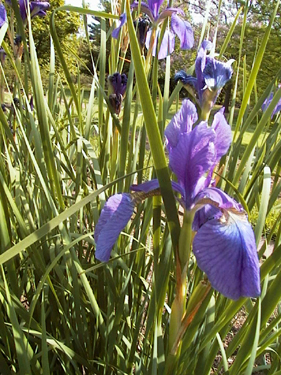Contents:
Common Names | Parts Usually Used | Plant(s) & Culture | Medicinal Properties
Legends, Myths and Stories | Uses | Warning | Bibliography
Scientific Names

- Iris versicolor L.
- Iridaceae
- Iris family
Common Names
- Blue Iris
- Flag lily
- Fleur-de-lis
- Flower de-luce
- Iris
- Liver lily
- Poison flag
- Snake lily
- Water flag
- Water lily
Parts Usually Used
Roots
Back to Top
Description of Plant(s) and Culture
Blue flag is a perennial,
Blue flag is an iris similar in foliage appearance to the sweet flag, Acorus calamus. Unfortunately for some, it has quite different properties and if mistakenly used internally as one might sweet flag, the results can be disastrous.
Back to Top
Medicinal Properties
Anti-inflammatory, alterative, cathartic, diuretic, laxative, resolvent, sialagogue, stimulant, vermifuge
Back to Top
Legends, Myths and Stories
About 800 species belonging to more than 50 genera have been described from temperate to tropical climates, mostly from South Africa and tropical America.
Back to Top
Uses
American Indians poulticed the root on swellings, sores, wounds, bruises, ulcers, takes away freckles, rheumatism; internally root tea was used as a strong laxative, emetic, and to stimulate bile flow. Useful in cancer, dropsy, impurity of blood, syphilis, skin diseases, liver troubles, and as a laxative.
Back to Top
Warning
This herb is potentially fatal. Could cause death or other serious consequences. Its use is not recommended without constant medical supervision.
Back to Top
Bibliography
 The Rodale Herb Book: How to Use, Grow, and Buy Nature’s Miracle Plants (An Organic gardening and farming book)
The Rodale Herb Book: How to Use, Grow, and Buy Nature’s Miracle Plants (An Organic gardening and farming book), edited by William H. Hylton, Rodale Press, Inc. Emmaus, PA, 18049., 1974
![]() American Folk Medicine
American Folk Medicine, by Clarence Meyer, Meyerbooks, publisher, PO Box 427, Glenwood, Illinois 60425, 1973
![]() Back to Eden
Back to Eden, by Jethro Kloss; Back to Eden Publishing Co., Loma Linda, CA 92354, Original copyright 1939, revised edition 1994
![]() The Complete Medicinal Herbal
The Complete Medicinal Herbal, by Penelope Ody, Dorling Kindersley, Inc, 232 Madison Avenue, New York, NY 10016, First American Edition, copyright 1993
 How Indians Use Wild Plants for Food, Medicine & Crafts
How Indians Use Wild Plants for Food, Medicine & Crafts, by Frances Densmore, Dover Publications, Inc., 180 Varick Street, New York, NY 10014, first printed by the United States Government Printing Office, Washington, in 1928, this Dover edition 1974
![]() Indian Herbalogy of North America
Indian Herbalogy of North America, by Alma R. Hutchens, Shambala Publications, Inc., Horticultural Hall, 300 Massachusetts Avenue, Boston, Massachusetts 02115, 1973
![]() The Yoga of Herbs: An Ayurvedic Guide to Herbal Medicine
The Yoga of Herbs: An Ayurvedic Guide to Herbal Medicine, by Dr. David Frawley & Dr. Vasant Lad, Lotus Press, Twin Lakes, Wisconsin, Second edition, 1988.
![]() Eastern/Central Medicinal Plants
Eastern/Central Medicinal Plants, by Steven Foster and James A. Duke., Houghton Mifflin Company, 215 Park Avenue South, New York, NY 10000
